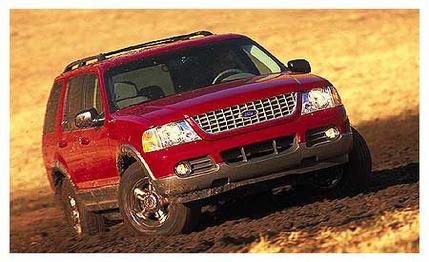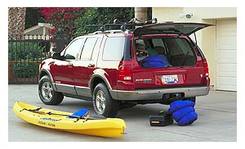 Road Test
Road Test
If the architects of quantum theory physics -- Planck, Einstein, Bohr, de Broglie, Schrodinger, Pauli, and Heisenberg -- were alive today, this septet of centenarians could all carpool down to the home for pensioner physicists in comfort in one 2002 Ford Explorer. The quiet cabin and smooth ride would provide a pleasant environment in which to share a few laughs about the old corpuscular theory of light and Al's hairdo. And these guys could probably tell you, via complex equations, about the quantum leap forward that the '02 Explorer represents. We'll try to do it in words.
The quantum mechanics involved in this transformation have their roots in a spanking-new chassis, which remains separate from the body but no longer bears any resemblance to that of a Ranger pickup truck. The new frame is nearly flat from end to end, with no dramatic kinks or kickups to clear big live axles, thanks to Ford's upgrade to unequal-length control arms at each corner. This flatter frame rides about two inches lower at either end to line up with car bumpers for improved crash friendliness. Furthermore, the rails of this new frame are fully boxed from front to rear -- a much stiffer design than that of the old "C-channel" rails. Computer modeling was employed to design the frame and its many boxed and hydroformed crossmembers with the ultimate goal of minimizing the relative motion of key points where the body and suspension pieces bolt up.
Similar computing power was used to develop the body to make it as rigid as the frame to prevent vibration modes that can arise from dramatic differences in body and frame rigidity. The result? Compared with the current models, the new Explorer and its Mercury Mountaineer sibling are 3.5 times as stiff in torsion despite an increase in both width and wheelbase of about two inches. By modern model-upgrade standards, that's a leap of several quanta.

To this superstructure is bolted a superb unequal-length-control-arm rear suspension with a toe-control link and a coil-over shock on each side. The cast-aluminum upper and boxed-stamped-steel lower control arms are long enough to provide a respectable eight inches of wheel travel. This design also helps lower the cargo floor by an incredible seven inches, making a third row of seats possible. The total system weighs a bit more than did the old live axle on leaf springs, but unsprung weight drops from 400 to 95 pounds. This reduces axle hop for improved acceleration and braking traction. Lateral compliance is also greatly reduced, enhancing cornering accuracy and improving dynamic stability -- especially when towing a trailer.
Up front, a switch from torsion bar springs to coil-over shocks allows for greater flexibility in ride tuning. Torsion bars prevented the lower control arms from absorbing any longitudinal impact harshness, and they were harder to tune for ride-height management under heavy loads. New aluminum knuckles and a wider track with longer control arms permit a tighter turning circle (36.7-foot diameter, down 16 inches) and an 85 percent reduction in scrub radius (this improves steering effort and feel).
The transformation in ride refinement and handling wrought by these upgrades is nothing short of astonishing. We drove old and new Explorers back-to-back over many of the toughest surfaces Ford uses to develop new cars at its Arizona proving grounds near Lake Havasu City. One rocky road traversed at 40 mph required a great deal of steering correction to maintain a straight heading in the old Explorer, but the new one motored straight through with minimal bucking and snorting. On a gymkhana course, the new one more willingly went where it was pointed with greater steering linearity. And during an 18-mile ride through a desert dry wash, the '02 model felt sure-footed and composed, although rough stretches got the seats moving around audibly and excited the doors in their frames a bit, signaling that this is still a body-on-frame vehicle.